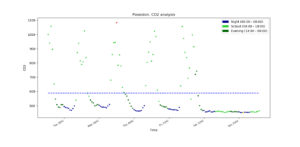Visiting my student’s Internet of Things Classroom
I’m still buzzing because today I had the opportunity to sit in on an introductory data science class for 15 year old pupils at a local high school, taught by one of my Informatics students. Bianca is nearing the end of the Computing in the Classroom course, which means she had to prepare and teach a computing lesson to a class of learners in her host school (Newbattle Digital Centre of Excellence). She and the teacher decided that she should work with the new Internet of Things (IoT) sensors which the school is trying out. The sensors are small mobile gizmos which can record temperature, CO2, pressure, humidity, sound and so on. They send the data securely back to the University computers over a low powered network called LORAWAN. It’s possible then to access the data from the university computers and try to make sense of it. The learners decided they wanted to measure CO2 levels and temperatures in particular classrooms which they often find hot and stuffy, and sound levels in open plan areas where they find it too noisy. Because this group of learners are just beginning to learn to program with a text-based language, Bianca helped them by writing “wrapper” python code which hid the complexity of the programming libraries for data processing but which still enabled them to use python functions within the Trinket programming environment to display graphs of the data and edit the graph formatting. When we arrived in the class, they were looking at some of the CO2 graphs and trying to figure out when the CO2 levels spiked. One of the learners told us that it CO2 levels matter because if there is too much CO2 in the class (above 2000 ppm), it makes everyone tired and they find it hard to focus. (They knew this because they researched it using multiple different websites, including that of Stephen Heppell.)

The visitors , teachers and the learners looked at the graphs together and spotted some occasions where certain sensors exceeded that – no wonder the young people found it hard to concentrate in one of those maths classrooms! One of the visitors (the Principal of the University) was quite particularly interested in why the temperature and CO2 readings might fluctuate differently, and spent a while musing over this with the young people. It was sheer magic to see school learners, university staff, visitors, teachers all thinking about data together under the inspiring guidance of a fourth year Informatics student. Hats off to Bianca!
By Judy Robertson



